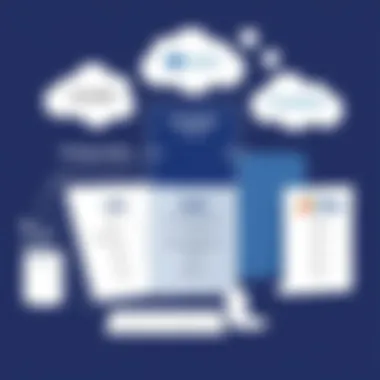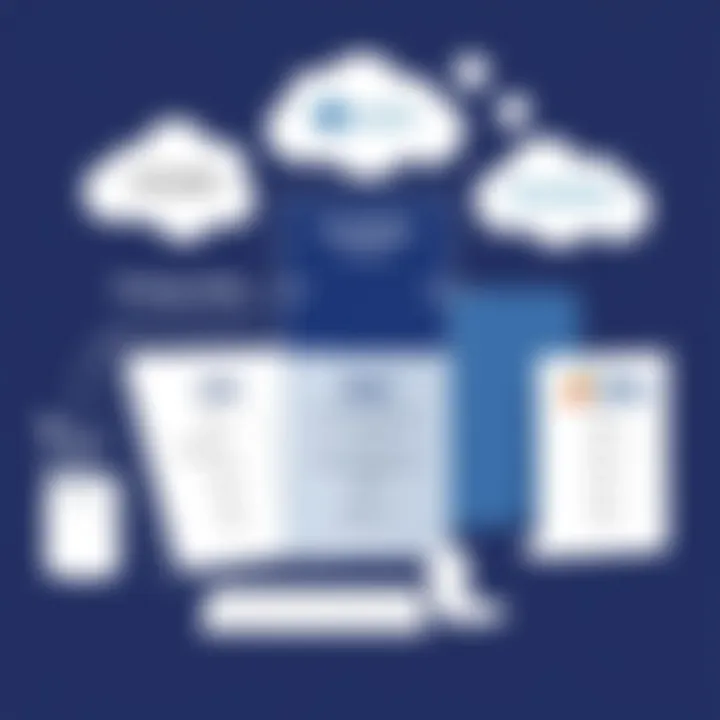Comparing Zendesk, Freshdesk, and Jira for Customer Support


Intro
In today’s rapidly evolving digital landscape, customer support platforms play a pivotal role in enhancing user experience. The market is brimming with solutions that promise to cater to various needs and preferences. Among these, Zendesk, Freshdesk, and Jira stand out as three formidable contenders. Each of these platforms brings something unique to the table, tailored for different types of organizations and customer support demands.
This article takes a closer look at these three applications, diving into their features, usability, and overall effectiveness. By providing a detailed comparison, we aim to equip readers—be they app enthusiasts or organizational decision-makers—with the necessary insights to make informed choices. Through our exploration, you will gather not just the surface information but a profound understanding of how each of these tools can fit within distinct workflows and operational frameworks.
Let’s embark on this insightful journey to dissect what makes Zendesk, Freshdesk, and Jira tick, and ultimately help you find the right fit for your support needs.
Preface to Customer Support Software
In the realm of business today, effective customer support isn't merely a complement to your services; it’s a cornerstone of success. The rise of digital communication has transformed how customers interact with brands, leading to an evolved expectation for timely assistance across various channels. Thus, understanding customer support software stands as a vital aspect for any organization eager to thrive.
The increasing complexity of customer interactions necessitates tools that can simplify and optimize responses. Customer support software enables businesses to manage inquiries, assist customers promptly, and gather valuable insights to refine their services. As companies branch out into multiple communication platforms, the significance of centralized management through software cannot be overstated.
Utilizing the right customer support tool impacts not only operational efficiency but also customer satisfaction and loyalty. When customers encounter seamless service, they are more likely to remain loyal to a brand. Therefore, understanding the objective benefits of such software, and recognizing your specific needs, should guide your choice in this arena.
“Technology is best when it brings people together.”
- Matt Mullenweg
Familiarity with the particular landscape of customer support tools — such as Zendesk, Freshdesk, and Jira — equips business leaders, app developers, and everyday users alike to make informed decisions. These platforms vary significantly in features and capabilities, lending themselves to different organizational requirements.
The implications of selecting the appropriate software tool stretch far beyond initial costs, including integration capabilities that lead towards better customer relationships. Thus, investing time in exploring these options is essential for ensuring long-term success and sustained growth.
Understanding Customer Support Needs
Understanding your organization’s specific customer support needs can make or break your support strategy. It’s not just about answering queries as they arise, but also about predicting what customers might need before they even ask. Assessing these needs begins by identifying the primary channels through which your clients reach out, be it email, social media, or live chat. Knowing where your customers hang out most allows you to streamline your support approach effectively.
Moreover, the nature of your customer base plays an influential role. Are they technically savvy, or do they require more hand-holding? This comprehension goes deeper into identifying the volume of inquiries, the types of issues commonly faced, and anticipating peaks in customer contact. For instance, during a product launch, customer inquiries can see a spike, requiring a scalable solution to manage heightened demand.
Understanding these nuances enables you to choose a software solution that can adapt to your organizational size, industry demands, and customer expectations. Not every tool offers the same breadth of functionalities, so conducting thorough research focused on specific customer interactions is key.
Importance of Choosing the Right Tool
Choosing the right customer support tool can feel like a daunting task, given the myriad options available. However, it is crucial to align your decision with your specific business needs to yield the best outcome. Tools like Zendesk, Freshdesk, and Jira each boast distinct features that cater to varying requirements, leading to considerable differences in user experience, efficiency, and ultimately, customer satisfaction.
The significance goes beyond functionalities — it dives into the realm of integration. A tool that harmoniously integrates with existing workflows can save time and drive productivity. For example, consider a tool that syncs seamlessly with your CRM system. Such integration allows holistic tracking of customer interactions, providing a 360-degree view, which proves invaluable in personalizing customer experience.
Additionally, support tools can provide data-driven insights, shaping business strategy and decision-making. Features such as analytics and reporting can unveil trends in customer behavior, allowing for timely adjustments and proactive customer service. Not to mention, a user-friendly interface is paramount in reducing the learning curve for teams, setting the stage for efficient utilization.
Ultimately, picking the correct tool can lead to a stronger, more responsive support system, enhancing overall business performance. Businesses that prioritize this strategic selection often find themselves reaping rewards in terms of customer loyalty and operational efficiency.
Overview of Zendesk
Zendesk, known for its wide-ranging capabilities, plays a crucial role in the customer support software landscape. It’s vital to understand its features and benefits because it addresses diverse customer service needs that can scale with businesses of all sizes. Its emphasis on user-friendliness paired with the ability to integrate seamlessly into various workflows makes it a compelling choice for many organizations.
Core Features of Zendesk
Ticket Management
In today’s fast-paced business environment, effective Ticket Management is paramount. Zendesk shines in this area, as it transforms incoming customer requests into manageable tickets. The unique aspect of its ticketing system is its flexibility to adapt to different needs. Whether it’s assigning tickets to specific team members or organizing them by priority, this system ensures that no query slips through the cracks.
One stand-out characteristic is the ability to automate ticket assignment based on predefined criteria, which optimizes workload distribution and efficiency. This automation feature can significantly reduce response times, resulting in higher customer satisfaction. However, one might argue that for very large organizations, managing a high volume of tickets may still lead to occasional bottlenecks.
Channel Integration
Zendesk’s Channel Integration functionality allows it to connect with a plethora of communication platforms, which is a game changer in today’s multi-channel world. This feature helps companies maintain a continuous conversation with customers by consolidating all communications—from email and social media to chat and phone—into a single dashboard.
The key advantage here is that it eliminates the need for switching between various applications, enhancing overall productivity. A unique feature of this integration is the capacity to manage interactions from different channels simultaneously, which fosters a seamless customer experience. Nonetheless, one potential drawback is that organizations may feel overwhelmed by managing multiple channels if not structured properly, leading to confusion.
Reporting and Analytics
When it comes to decision-making, reporting and analytics become the backbone of strategic operations. Zendesk offers robust analytical tools that provide insightful reports on customer interactions, agent performance, and overall satisfaction levels. A notable benefit of these features is the real-time data access that informs better decision-making.
The unique feature lies in its customizable dashboards, which allow teams to track metrics that matter most to them. However, there is a learning curve associated with interpreting this data, which might challenge users who aren’t data-savvy. Overall, though, the advantages of making data-driven decisions can’t be overstated.
Usability and User Interface
Zendesk prides itself on a clean and intuitive interface that aims to make every user's journey straightforward. The layout is designed so that even a novice user can navigate through the software with relative ease. The aesthetic appeal, combined with practical functionality, creates an environment conducive to efficient customer support operations. However, some may find that the depth of functionalities can initially overwhelm those unfamiliar with customer support software.
Pricing Structure
Free Trial Options
Zendesk offers a free trial option, which stands out in a competitive marketplace. This allows potential users to experience the platform's capabilities without upfront investment. It’s a solid choice for organizations that wish to evaluate features before committing financially. However, trial limitations may restrict access to certain premium features, which could impact the user experience during the testing phase.
Monthly Plans


The monthly plans offered by Zendesk cater to varying organizational needs. Each tier provides a different set of features, enabling businesses to opt for a plan that aligns best with their requirements. The flexibility of these plans serves as a significant advantage for startups and smaller enterprises. However, the costs can add up quickly as organizations scale, which may not always be feasible for every budget.
Enterprise Solutions
For larger organizations, Zendesk’s enterprise solutions present a tailored approach aimed at complex operations. These solutions usually incorporate enhanced features and dedicated support, making them highly attractive for businesses that require a robust customer support structure. The highlight here is the additional customization options that can facilitate integration into existing workflows. Nevertheless, with such customization, organizations might face challenges regarding implementation timelines and resource allocation.
Overview of Freshdesk
When it comes to customer support, Freshdesk stands out as a compelling option. This platform offers a unique blend of features, usability, and pricing that can attract different kinds of businesses, from startups to larger enterprises. Understanding how Freshdesk functions is pivotal for businesses looking to enhance their customer service management. In this section, we will explore its core features, usability, and pricing structure, providing insights into why it may be a fitting choice for various support needs.
Core Features of Freshdesk
Multi-Channel Support
Multi-channel support is a standout feature of Freshdesk, allowing businesses to connect with customers through a variety of platforms. This integration means support teams can handle inquiries from emails, social media, web chats, and even phone calls all in one place. The key characteristic here is the ability to track every communication thread, ensuring no query slips through the cracks.
This makes Freshdesk a popular choice for businesses that want to streamline their customer interaction processes. One unique feature is the ability to customize the support channel options that are accessible to customers. For instance, companies can choose to prioritize their chat and email options based on customer preferences. However, while this feature is advantageous, managing multiple channels can sometimes lead to complexity, especially for smaller teams.
Automation Capabilities
Another significant aspect of Freshdesk is its automation capabilities. This feature allows businesses to set up workflows that reduce manual tasks and improve efficiency. Automation can manage ticket routing, escalation processes, and even automated responses for frequently asked questions.
The key characteristic here is ease of use; even those not particularly tech-savvy can set up automated flows with minimal training. An advantage of automation is the increased speed with which queries are handled, as routine tasks can be processed without human intervention. Nevertheless, there may be a limited ability to fine-tune these automations which could be a drawback for some businesses needing highly customized solutions.
Knowledge Base Creation
Creating a knowledge base is an essential feature in Freshdesk, helping customers find answers to their questions without needing direct support. This contributes significantly to a smoother user experience, allowing users to solve problems independently.
The key characteristic of this feature is its user-friendly interface which enables easy content creation and organization. A distinctive advantage here is that it not only aids users but also reduces the volume of tickets that customer support teams receive, enhancing overall efficiency. However, while the knowledge base can substantially improve self-service options, it requires consistent updates to remain relevant and helpful, challenging those with fewer resources.
Usability and User Interface
When discussing usability, Freshdesk excels with its intuitive interface that caters to a wide range of users. It's designed to be welcoming even for those who are not tech experts. A clean layout contributes to easy navigation—buttons and features are logically placed, which helps significantly reduce the learning curve. Users generally find it easy to locate needed functionalities quickly, which is crucial in a fast-paced support environment.
Additionally, its adaptability ensures that users can customize their views based on their daily tasks and priorities. This flexibility means that support agents can prioritize their workflows effectively. However, some users might feel overwhelmed by the number of options available, particularly if they are not accustomed to such detailed platforms.
Pricing Structure
Evaluating Freshdesk's pricing structure reveals a commitment to providing options suitable for businesses of all sizes. Its various plans cater to startups as well as larger organizations, allowing every entity to find a suitable fit. The transparency in pricing is also a significant advantage, as potential clients can clearly see what each tier includes without hidden costs.
Free Options
Freshdesk also provides a free tier suitable for small organizations or teams just starting. This option includes basic functionalities like email support and a ticketing system, which can be very attractive for those looking to test the waters or for startups that need to keep costs low.
The key characteristic of this tier is that it gives users a chance to evaluate the software without upfront financial commitment. Its advantages lie in the risk-free trial, but potential clients should be aware that advanced features may become necessary as businesses grow.
Feature-Based Plans
The feature-based plans offer various levels of functionality, catering to growing business needs. Different pricing tiers unlock additional capabilities, such as automation, advanced reporting, and more robust customization options.
Its key characteristic is flexibility, allowing companies to select a plan that corresponds with their current demands and scale up as necessary. This adaptability makes it a beneficial choice for businesses anticipating growth. However, determining which features are essential for your operations can sometimes be a challenge due to the complexity of options.
Custom Pricing
For larger enterprises or those with specific requirements, Freshdesk offers custom pricing solutions. This allows organizations to engage directly with the Freshdesk team to tailor a package that meets their unique expectations.
The key characteristic here is personalization; businesses can negotiate the features they require, ensuring they are not paying for unnecessary components. Furthermore, custom pricing can be appealing to those with complex needs that standard plans cannot address. Nonetheless, engaging in negotiations might not be straightforward and can sometimes lead to longer onboarding processes.
This overview of Freshdesk offers significant insight into what businesses can expect when considering the platform, including its range of features, ease of use, and attractive pricing mechanisms. As with any tool, evaluating each category against specific organizational needs is crucial for making an informed decision.
Overview of Jira
Jira has established itself as a pivotal player in the realm of project management and issue tracking software. It’s more than just a tool; it’s a comprehensive ecosystem tailored to enhance productivity and improve workflow. Understanding Jira in this article is essential because it juxtaposes the offerings of Zendesk and Freshdesk, allowing decision-makers to see where it stands in terms of functionality and usability.
As organizations grapple with dynamic work environments, having a robust tool like Jira can streamline operations. It accommodates both technical and non-technical teams, making it versatile and applicable across various sectors. This overview aims to illuminate why Jira remains a preferred choice for many professionals seeking an integrated solution for managing projects and customer-related activities.
Core Features of Jira
Project Management Tools
One of the standout elements of Jira is its extensive project management tools. The platform goes beyond simple task tracking, offering features like agile boards, roadmaps, and backlog prioritization. These tools allow teams to plan their work effectively and adapt to changes in real time. The capacity for team collaboration is greatly enhanced through these functionalities.
A key characteristic of Jira’s project management tools is their flexibility. For instance, teams can switch between Scrum and Kanban methodologies effortlessly, depending on their project requirements. Unique to Jira is the ability to create custom workflows. This specificity can significantly aid project tracking and accountability.
However, it’s worth noting that initial setup can be overwhelming. New users might find the learning curve steep, which could hinder quick adoption.
Agile Workflow Support


Jira’s commitment to agile methodologies cannot be overstated. The platform offers robust support for scrum and kanban practices, which are key in modern workflow settings. This aspect contributes significantly to teams aiming for quicker iterations and continuous delivery.
One of its hallmark features is the sprint planning capability, which allows teams to allocate tasks based on their capacity and velocity. Many users appreciate this adaptability, as it helps in aligning short-term goals with long-term outcomes.
On the flip side, while the agile tools are powerful, they can also become cumbersome in workflows not strictly adhering to agile principles. This duality means teams must evaluate their own processes before fully committing to leveraging these capabilities.
Customizable Dashboards
Another critical feature is the customizable dashboards that Jira provides. This allows users to curate their own views of project statuses, upcoming deadlines, and team performance metrics. Teams can filter data to show what matters most, which makes it easier to stay on top of important projects.
The customization aspect is particularly popular because it can accommodate personal preferences and varying team needs. Users can integrate third-party apps for enhanced functionality, creating an all-inclusive workspace.
Yet, customization can also lead to inconsistencies. Different teams may build entirely divergent dashboards, which can confuse members unfamiliar with diverse setups. Maintaining uniformity across teams is a challenge that organizations need to address as they implement this feature.
Usability and User Interface
Jira’s user interface is designed to be functional. However, opinions on usability vary. While seasoned users appreciate the depth of features, newcomers may find it cluttered and unintuitive at times. The interface's complexity can detract from their initial experience. However, regular updates and a focus on user experience aim to address these concerns.
Pricing Structure
Free Tier
Jira’s free tier offers a way for small teams or startups to engage without initial financial commitments. It allows for a limited number of users and basic features, serving as a gateway for organizations considering full adoption later.
This feature is particularly beneficial for startups looking to minimize costs while testing out the platform's potential. Yet, the constraints of the free tier can feel restrictive for growing teams, potentially necessitating an upgrade sooner than expected.
Paid Plans
Jira’s paid plans come with a rich array of features amplifying what the free tier provides. Different plans cater to various organizational needs from small teams to large enterprises. This pricing structure is designed to grow alongside a business, ensuring scalable options.
One key element of the paid plans is the enhanced support and additional features like automation tools. They enable users to optimize their workflows further. However, the escalating costs can become a consideration for larger teams that require extensive functionalities or integrations.
Enterprise Pricing
Enterprise pricing is tailored for larger organizations that demand advanced features and stronger service agreements. This pricing model reflects Jira’s capability to support intricate projects and multiple teams working on various processes.
For large enterprises, having guaranteed availability and robust support is essential, and the enterprise pricing tier addresses these demands effectively. While the pricing may deter smaller organizations, it ensures that large teams get value aligned with their needs.
Comparative Analysis of Key Features
When choosing a customer support solution, the tool's features can make or break the experience. Understanding how Zendesk, Freshdesk, and Jira stack up against one another in various key areas is paramount for any organization. This comparative analysis delves into integration capabilities, reporting and analytics, and customization options. By evaluating these aspects, decision-makers can pinpoint which platform aligns best with their operational needs and supports their customer interaction goals.
Integration Capabilities
Third-Party Apps
Integrating with third-party applications is a pivotal consideration for any customer support software. These apps multiply functionality and streamline workflows, creating smoother experiences for users. Zendesk, Freshdesk, and Jira all boast impressive ecosystems that allow for easy integration with various tools such as CRM systems, project management software, and communication platforms.
For example, integrating Freshdesk with Google Workspace can enhance collaboration in businesses already relying on Google’s suite. By tapping into these services, users fetch the best of both solutions, increasing productivity.
However, it's also essential to weigh the costs against their benefits. Some third-party integrations carry additional fees or require technical know-how, which could be a roadblock for smaller companies or those with limited resources. Nonetheless, if done right, integrating third-party apps can be a game changer in how customer support operates, enabling a tailored experience that matches specific business needs.
API Access
API access is another crucial feature that merits attention. It provides developers with the tools to create custom integrations and automations, fostering greater flexibility and control over how the software fits into the existing tech stack. For instance, Zendesk’s API enables users to automate ticket creation, allowing for smoother workflow from the outset. The key characteristic of API access is its potential for customization. Companies can tailor the systems precisely to their workflows rather than conforming to a one-size-fits-all solution. But this also comes with a caveat—API integration requires technical expertise, which might be scarce in some organizations.
In summary, while third-party apps and API access offer significant advantages, such as enhanced functionality and personalized workflows, they necessitate a level of skill and resources that not all teams possess. Before jumping headfirst into integrations, a careful evaluation of internal capabilities is wise.
Reporting and Analytics
Reporting and analytics are crucial for companies seeking to improve customer service. The ability to track performance metrics enables organizations to identify trends, measure satisfaction, and ultimately guide strategic decisions. In this context, Zendesk, Freshdesk, and Jira offer different strengths in their reporting functionalities.
Zendesk, for instance, provides robust analytics tools that offer insights into ticket volume, response times, and resolution rates. These insights can be pivotal for refining support strategies. Conversely, while Freshdesk offers reports that are easy to generate and understand, they may lack the depth found in more sophisticated tools like Zendesk.
Jira stands out for project-focused teams by integrating reporting features that align with agile marketing workflows. Users can see not just customer support metrics but also how they impact project timelines—providing an invaluable perspective on resource allocation and performance. Each of these platforms has its own strengths and weaknesses in reporting, and the best choice hinges upon specific analytical requirements.
Customization Options
Customization is paramount when it comes to tailoring a customer support platform to fit an organization’s workflows. Each of the platforms—Zendesk, Freshdesk, and Jira—provides tools that allow users to make adjustments to suit their needs.
For example, Jira offers detailed customization options that cater to agile teams, allowing them to create specific workflows, issue types, and custom fields that align with their project requirements. This level of configurability can enhance user experience and increase efficiency.
On the other hand, Freshdesk's customization leans more towards aesthetics and user interaction, offering templates and theming options that help companies maintain brand consistency. While these customization features are beneficial, they may not satisfy the complex needs of businesses that require granular configuration like those offered by Zendesk or Jira.
Ultimately, the choice among these platforms revolves around how much customization is truly needed. A business focused on project management may favor Jira, whereas a company that prioritizes branding may lean toward Freshdesk. Each tool brings its unique flavor of customization but understanding your organization's specific needs is crucial in making the right decision.
User Experience and Interface Design
Designing a tool that meets the demands of users is crucial. User experience (UX) and interface design (UI) play a paramount role in how customer support software like Zendesk, Freshdesk, and Jira is perceived and utilized. A smooth UX not only simplifies tasks but also enhances retention and satisfaction across teams that interact with these platforms.


Ease of Navigation
When we speak of user experience, navigation is the backbone. If users can't find their way through a tool, they're bound to get frustrated and may abandon it altogether. Zendesk, Freshdesk, and Jira each take a unique approach to navigation.
- Zendesk: The design is clear-cut with a sidebar offering quick access to essential features. This is like having a well-organized toolbox where everything is easy to spot and grab. Users can effortlessly shift from the dashboard to tickets or analytics without feeling lost.
- Freshdesk: It takes a more colorful route. The navigation bar is vibrant, resembling a well-lit street market, which engages users visually. However, while the interface is appealing, some might find the options overwhelming due to the myriad of features available.
- Jira: As a favorite among developers, its navigation might feel more technical. It prioritizes quick access to project management tools. For seasoned users, this inefficiency aligns with their needs, but beginners might need some time to acclimate.
An effective navigation structure reduces the learning curve, elevating the overall experience. A few clicks to get to essential areas shows good design principles at work.
Accessibility Features
Accessibility in software is often overlooked, yet it is essential to cater to diverse user needs. A tool that is difficult to navigate for someone with disabilities can hinder efficient customer support. Each platform carries its own accessibility features.
- Zendesk: Offers screen reader compatibility, ensuring visually impaired users can interact with functions seamlessly. This fosters inclusivity, making sure no one gets left behind.
- Freshdesk: Similar in offering, it also has keyboard shortcuts, which can be a lifesaver when mouse navigation isn't an option. In fact, these features resonate with the need for a more user-friendly approach, especially for those with physical challenges.
- Jira: Its accessibility tools are a bit more comprehensive. Through customizable visual elements and color contrasts, it allows users to adjust the interface as per their comfort. Standard symbols help create a uniform user experience, making it easier for all to use.
Incorporating accessibility features isn't just a box to check off; it ensures every user benefits from the service's full capabilities.
"A platform must be a bridge, not a barrier to effective communication."
In summary, the focus on user experience and interface design in customer support software is not merely an aesthetic choice; it is fundamentally about enhancing the usability of the tool for a diverse crowd. Companies investing time into understanding user navigation and accessibility can create a more effective environment, ultimately leading to better support and business outcomes.
Customer Support and Community Resources
In the realm of customer support software, the caliber of support and community engagement you can count on plays a pivotal role. Having a robust customer support system means that users can rely on timely assistance and guidance, which in turn ensures they can make the most of the tools at their disposal. For app developers, tech-savvy users, and beginners, a well-supported platform can drastically cut down on downtime when facing technical issues or seeking to maximize the software’s potential.
Support Channels Offered
When it comes to effective customer support, variety is key. A comprehensive suite of support channels can truly make or break a user’s experience with a software solution. Here’s a closer look at how Zendesk, Freshdesk, and Jira stack up in this regard:
- Zendesk offers multiple channels including email, live chat, and phone. They also provide a user-friendly help center, where customers can find shipping and troubleshooting guides.
- Freshdesk doesn’t fall behind either, with its own combination of email support, ticket submission, and chat functionalities. Furthermore, they feature social media integrations for support queries, allowing users to directly reach out through platforms like Twitter and Facebook.
- Jira focuses heavily on supporting project management teams, thus providing channels such as personalized email support and an elaborate help center. Although they lack live chat no less than the other two, they offer a staggering amount of documentation and guides to assist users.
Each of these platforms acknowledges that solid support minimizes user frustration. Therefore, they continually improve how they deliver their support services.
Community Engagement and Forums
Community engagement can significantly enhance the experience of using any software. It allows users to share experiences, troubleshoot together, and learn from one another. Here's how each platform fosters a thriving community:
"The strength of a community can often empower users far beyond basic support functions—making fellow users an invaluable resource."
- Zendesk possesses an active community forum where users can ask questions and discuss various topics about the software. This fosters a collaborative learning environment where experienced users often jump in to assist others.
- Freshdesk takes community engagement a step further with its public forum and blog, where updates and best practices are shared. This cultivates an environment where users can contribute and not just consume information.
- Jira also has a dedicated community space known as Atlassian Community, where users can pose questions, seek expertise, and engage in lively discussions. Jira users benefit from a wealth of shared configurations and use-case scenarios, making complex projects feel more manageable.
For further exploration of community resources, consider visiting the respective forums: Zendesk Community, Freshdesk Community, and Atlassian Community for Jira.
Use Cases and Best Practices
Understanding the specific use cases for Zendesk, Freshdesk, and Jira is essential for organizations to choose the right tool that meets their unique customer support needs. The right software can streamline operations, enhance communication, and improve overall service delivery. Each platform has distinct strengths that cater to varying types of businesses or customer support scenarios. Therefore, rather than simply comparing features, it’s crucial to consider practical applications that align with specific organizational practices.
Choosing the Right Tool for Your Business
When contemplating which customer support solution to implement, it's imperative to assess the particular needs of your business. Here are some key elements to consider:
- Business Size: Larger companies may require more comprehensive solutions like Jira that integrate project management, while smaller teams might find Freshdesk's simplicity more appealing.
- Nature of Support Required: If your organization deals with a multitude of customer inquiries, Zendesk’s multi-channel support can be advantageous. Alternatively, if you follow agile methodologies, Jira's project management features might be better suited.
- Integration Requirements: Evaluate your existing technology stack. Tools like Zendesk offer numerous integrations with third-party applications, which can provide a seamless workflow. Make sure the platform you choose can connect with the tools you already have.
Thus, tailoring your choice to your organizational context greatly increases the chances of successful implementation and user adoption.
Success Stories and Case Studies
Many organizations have successfully implemented these customer support solutions, yielding tangible benefits in their operations. Here's a glance at real-world applications:
- Zendesk at Shopify: The e-commerce giant leverages Zendesk to enhance customer interactions across multiple channels. The flexibility of their ticketing system streamlined the support process, ultimately improving resolution times significantly.
- Freshdesk for Freshworks CRM: This company utilizes Freshdesk to offer support not only to their products but also their clients. By employing automation features, they’ve reduced response times, allowing agents to focus on complex cases.
- Jira's Use in Software Development at Atlassian: Atlassian itself uses Jira to manage its internal projects. By employing Jira’s customizable dashboards, they can monitor progress, track bugs, and streamline their software development cycles efficiently.
These examples highlight the practical impact of choosing the right tool aligned with business practices. When selected wisely, these platforms not only facilitate customer interactions but also enhance team collaboration and productivity.
"The best tool is the one that integrates seamlessly into your existing workflows, making processes smoother rather than complicating them."
By reflecting on these success stories, businesses can gather insights about their operational requirements and implement best practices that enhance their customer support systems.
End
In the world of customer support, effective tools can mean the difference between thriving and just surviving. This article has delved into the specifics of Zendesk, Freshdesk, and Jira, highlighting their distinct features and benefits. Understanding these differences is paramount for businesses that want to optimize their customer interactions and support processes.
Choosing the right support software isn't merely about picking a popular option; it's more about fitting the tool to the unique needs of your company. Each of the platforms has its strengths—Zendesk is often lauded for its versatility and integration capabilities, Freshdesk tends to shine in affordability along with its comprehensive multi-channel support, while Jira excels in project management alongside agile methodologies.
Additional considerations come into play as well.
- Scalability: A growing business may prioritize solutions that can easily adjust to increasing demands.
- Ease of training and onboarding: For teams looking to hit the ground running, usability can have a significant impact on adoption rates.
- Customer data security: In an era of heightened awareness about data privacy, ensuring that the chosen tool adheres to stringent security standards is non-negotiable.
Ultimately, a well-informed selection not only enhances user experience but also enriches organizational workflows. The right choice leads to better customer satisfaction, improved operational efficiency, and in the end, a more vibrant business environment.
"Invest in a tool that supports your unique processes rather than changing your processes to fit a tool."
Final Thoughts
As we wrap this discussion, it's crucial to remember that while Zendesk, Freshdesk, and Jira offer robust functionalities, the best choice varies depending on individual business needs and team dynamics. Take those individual aspects into account before deciding. When in doubt, don't hesitate to take advantage of free trials or demo sessions to gain hands-on experience. After all, experiencing the platform firsthand can provide priceless insights that brochures and reviews simply can't convey.
In tackling customer support challenges, the choice of software sets the stage for success in any customer-driven landscape.







